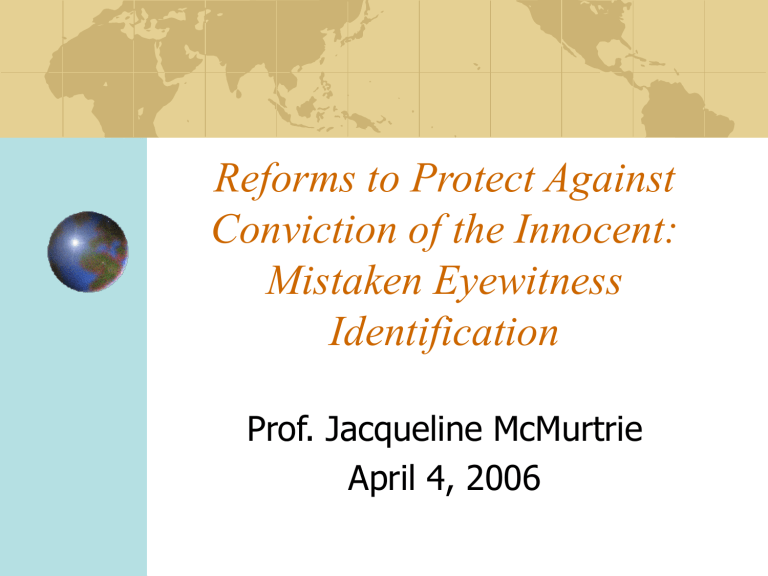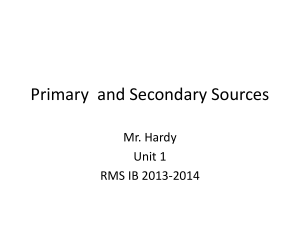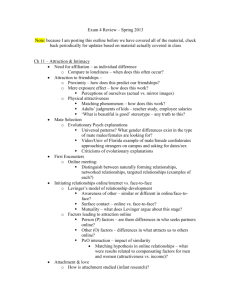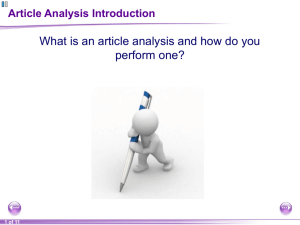Powerpoint

Reforms to Protect Against
Conviction of the Innocent:
Mistaken Eyewitness
Identification
Prof. Jacqueline McMurtrie
April 4, 2006
Wrongful Convictions
The Innocence Project
175 inmates released through DNA testing.
Exonerations in the United States (Gross et al.)
328 exonerations from 1989 - 2003.
144 DNA and 196 non-DNA.
Innocence Project Northwest
11 wrongfully convicted inmates released since 1997.
Factors Leading to Conviction of the Innocent
Mistaken eyewitness identification.
Coerced confessions.
Unreliable forensic laboratory work.
Police misconduct.
Prosecutorial Misconduct.
Ineffective representation by
Counsel.
Factors Leading to Wrongful Convictions in 62 U.S. Cases
60
50
40
30
20
10
0
DNA
Inclusions
Other
Forensic
Inclusions
False
Confessions
Informants/
Snitches
Bad
Lawyering
Microscopic
Hair
Comparison
Defective or
Fraudulent
Science
Prosecutorial
Misconduct
Police
Misconduct
Serology
Inclusion
Mistaken
ID
1 5 15 15 15 17 18 21 26
Factors Leading to Wrongful Convictions
32 52
Scheck, Neufeld & Dwyer, ACTUAL INNOCENCE (2000)
Reforms to Protect the Innocent
Mistaken eyewitness identification.
Schemas
Script – events where we expect a particular sequence of events to occur.
Role – occupations, social roles, or social groups.
Person – Different personality types .
Witnessing an Event.
Click on the next slide to witness a videotaped event. You will view the event from perspective of camera. Put yourself in the shoes of the person whose arm you see opening the office door.
After you view the event, immediately write down a description of what has just occurred. Describe in detail the person you observed (age, height, weight, clothing), and the person’s precise actions. Try to include as many details as possible.
Viewing a photomontage
Imagine that you have now been brought to the police station to view a photomontage.
Do you think the police have identified a suspect?
The next slide is the photomontage.
Do you see the suspect? Who is it?
1
4
2 3
5
6
Reforms to Protect the Innocent
Mistaken eyewitness identification.
“Double-blind” identification procedures.
• Positive feedback distorts confidence and reinforces false identification.*
* Bradfield, Wells & Olson, The Damaging Effect of Confirming Feedback on the Relation Between Eyewitness Certainty and Identification Accuracy,
JOURNAL OF APPLIED PSYCHOLOGY, 87, 112-120 (2002).
Click on the next slide to see the actual perpetrator.
1
4
2 3
5
6
Reforms to Protect the Innocent
Mistaken eyewitness identification.
“Double-blind” identification procedures.
• Positive feedback distorts confidence and reinforces false identification.*
Sequential, rather than simultaneous identification procedures.
• Relative Judgment
* Bradfield, Wells & Olson, The Damaging Effect of Confirming Feedback on the Relation Between Eyewitness Certainty and Identification Accuracy,
JOURNAL OF APPLIED PSYCHOLOGY, 87, 112-120 (2002).
Click on the next slide to see how a sequential photomontage procedure would be administered.
Reforms to Protect the Innocent
Mistaken eyewitness identification.
“Double-blind” lineups
• Positive feedback distorts confidence and reinforces false identification
Sequential, rather than simultaneous lineups
• Relative Judgment
“Fillers” that Match description of perpetrator, not suspect
Disclaimer
Continuum of identification






